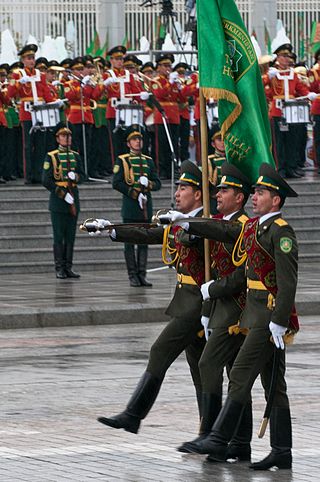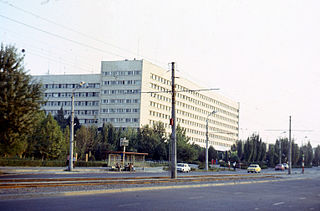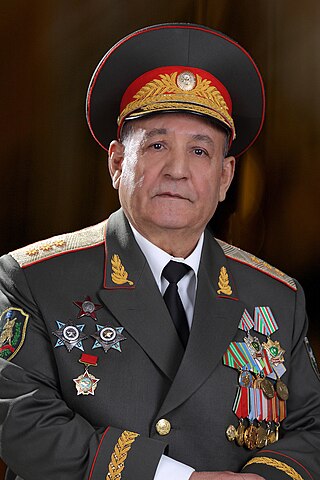The 11th Motor Rifle Division "Sultan Sanjar" is a unit of the Turkmen Ground Forces. It descends from the 88th Motor Rifle Division of the Soviet Army, first formed in May 1957. It is currently based out of Serhetabat (formerly Kushka).
The 11th Motor Rifle Division "Sultan Sanjar" is a unit of the Turkmen Ground Forces. It descends from the 88th Motor Rifle Division of the Soviet Army, first formed in May 1957. It is currently based out of Serhetabat (formerly Kushka).
In May 1957, the 88th Motor Rifle Division (First Formation) was established at Belgorod-Dnestrovsky in Ukraine from the 14th Rifle Division (Odesa Military District). It was redesignated the 180th Motor Rifle Division in November 1964. [1] In 1980, it was reestablished at Kushka, in the Turkmen SSR. It replaced the 5th Guards Motor Rifle Division of the Turkestan Military District, which had been dispatched to Afghanistan. In 1982, it came under the control of the 36th Army Corps. In March 1989, it absorbed the returning 5th Guards Motor Rifle Division without inheriting any awards.
After the dissolution of the Soviet Union, the unit was inherited by the Government of Turkmenistan. In May 1992, it was taken over by the Armed Forces of Turkmenistan. According to former Soviet Ground Forces personnel, after the collapse of the Soviet Union, the 5th Guards Motorized Rifle Division was renamed into a division named after Saparmurat Niyazov with a deployment in Kushka. [2] According to other sources, the name of Turkmenbashi was assigned to the 22nd Motorized Rifle Division stationed in the city of Kizyl-Arvat (now Serdar). [3] In July 2004, by the decree of the President of Turkmenistan Niyazov, the division was renamed to the Turkmen 11th Motor Rifle Division, [4] "Sultan Sanjar", named after Sultan Ahmad Sanjar. [5] Its forces are concentrated on the Afghanistan-Tajikistan border. [6]

The history of Turkmenistan traditionally began with the arrival of Indo-European Iranian tribes around 2000 BC. Early tribes were nomadic or semi-nomadic due to the arid conditions of the region, preventing widespread adoption of agriculture. The steppe culture in Central Asia was an extension of a larger Eurasian series of horse cultures which spanned the entire spectrum of language families, including the Indo-Europeans and Turko-Mongol groups. Some of the known early Iranian tribes included the Massagatae, the Scythians/Sakas, and early Soghdians, who were most likely precursors of the Khwarezmians. Turkmenistan was a passing point for numerous migrations and invasions by tribes, which gravitated towards the settled regions of the south, including ancient Mesopotamia, Elam, and the Indus Valley civilization.

The Armed Forces of Turkmenistan, known informally as the Turkmen National Army is the national military of Turkmenistan. It consists of the Ground Forces, the Air Force and Air Defense Forces, Navy, and other independent formations.

The 8th Guards Order of Lenin Combined Arms Army is an army of the Russian Ground Forces, headquartered in Novocherkassk, Rostov Oblast, within Russia′s Southern Military District, that was reinstated in 2017 as a successor to the 8th Guards Army of the Soviet Union's Red Army, which was formed during World War II and was disbanded in 1998 after being downsized into a corps. Military Unit в/ч 61877.
A mechanised corps was a Soviet armoured formation used prior to the beginning of World War II and reintroduced during the war, in 1942.

The Ministry for National Security or MNS is the secret police agency for the government of Turkmenistan. It is composed largely of the remnants of KGB organs left over after the collapse of the Soviet Union; its functions remain largely the same as well. The MNB and the national police force are under the direction of the Ministry of Internal Affairs. Until 2002, it was known as the KNB.

The Turkestan Military District was a military district of both the Imperial Russian Army and the Soviet Armed Forces, with its headquarters at Tashkent. The District was first created during the 1874 Russian military reform when by order of Minister Dmitry Milyutin the territory of Russia was divided into fourteen military districts. Its first commander was Konstantin Petrovich von Kaufmann, who was also Governor-General of Russian Turkestan at the time.

The 40th Army of the Soviet Ground Forces was an army-level command that participated in World War II from 1941 to 1945 and was reformed specifically for the Soviet–Afghan War from 1979 to circa 1990. The Army became the land forces arm of the Soviet occupational force in Afghanistan in the 1980s, the Limited Contingent of Soviet Forces in Afghanistan.

The 108th Nevelskaya Motor Rifle Division, abbreviated as the "108th MRD," was a unit of the Soviet Ground Forces and the Armed Forces of Uzbekistan. It was the successor to the 360th Rifle Division. The division was created in August 1941 by the State Defense Committee and the Volga Military District Commander, Vasily Gerasimenko, in the Volga Military District. The 360th compiled a distinguished record of service during the Great Patriotic War on the northern sector of the Soviet-German front, including the award of a battle honor and the Order of the Red Banner.
The 5th Guards Zimovnikovskaya order Kutuzov II degree Motor Rifle Division, named on the 60th anniversary of the USSR, was a military formation of the Soviet Ground Forces. It was formed from the 6th Mechanized Corps created in 1940 and destroyed in 1941 in the beginning of Operation Barbarossa. The corps was reformed in November 1942 under the same name, but with a different organizational structure. In January 1943, the 6th Mechanized Corps was granted "Guards" status and became the 5th Guards Mechanized Corps.
The 14th Guards Combined Arms Army was a field army of the Red Army, the Soviet Ground Forces, and the Russian Ground Forces, active from 1956 to 1995. By the 1990s, according to sources within the 14th Army, the majority of its troops came from what would become the Pridnestrovian Moldavian Soviet Socialist Republic, with 51% of officers and 79% of draftees coming from this region.
The 22nd Motor Rifle Division named for Atamyrat Niyazov is a division of the Turkmenistan Ground Forces. It traces its history to the 344th Rifle Division, an infantry division of the Red Army and the Soviet Ground Forces during World War II and the Cold War.
The 79th Motor Rifle Division was a motorized infantry division of the Soviet Army. It was converted from the 79th Rifle Division in 1957 and inherited the honorific "Sakhalin". The division was awarded the Order of the Red Banner. The 79th Rifle Division fought in the Invasion of South Sakhalin in 1945 and was based at Leonidovo for most of its career.

The 70th Separate Guards Motor Rifle Brigade was a Soviet Ground Forces mechanized infantry brigade of the Soviet–Afghan War. During the war, it was based in Kandahar.

The Turkmen Ground Forces is the army branch of the Armed Forces of Turkmenistan. The ground forces include the 2nd, 3rd, 11th, and 22nd Motor Rifle Divisions as well as smaller units consisting of various types of troops.

The Russian Tank Troops is the armored warfare branch of the Russian Ground Forces. They are mainly used in conjunction with the motorized rifle troops in the main areas and perform the following tasks:
Annamurat Soltanovich Soltanov was a Turkmen general who served as the first chief of the general staff of the Armed Forces of Turkmenistan.
The 2nd Training Motorized Rifle Division named after Alp Arslan is a division of the Turkmen Ground Forces. Its headquarters is at Tejen in the Ahal Region. It traces its history to the 357th Rifle Division formed in August 1941 in Sarapul in the then Udmurt Autonomous Soviet Socialist Republic as a standard Red Army rifle division. It notably served on the front lines of the 1st Baltic Front during the Second World War. Particularly, it helped lead the 3rd Shock Army in the battle and siege of Velikiye Luki. By late October 1945, the division had been transferred to the Turkmen SSR, where it was re-designated four times as Soviet Army unit. It remained in Turkmenistan even after the events of 1991 and serves as one of four units in its armed forces.

The 27th Separate Guards Sevastopol Red Banner Motor Rifle Brigade "60th Anniversary of the USSR" is a tactical formation of the Russian Ground Forces. Its Military Unit Number (V/Ch) is 61899. It is part of 1st Guards Tank Army of the Western Military District, stationed in Mosrentgen, Novomoskovsky Administrative Okrug of Moscow.
Lieutenant General Ilýa Weljanowiç Weljanow was a Soviet-Turkmen politician and diplomat, as well as a Belarusian public figure. He is the first Turkmen general in the Soviet Armed Forces and the first Lieutenant general of the Armed Forces of Turkmenistan.

Tulkun Kasimov is a Soviet-Uzbek retired military officer who has served as first person to hold the post of Chief of the Joint Headquarters of the Armed Forces of the Armed Forces of Uzbekistan from 2000 to 2003. After retirement, he served in the reserve of the Armed Forces.